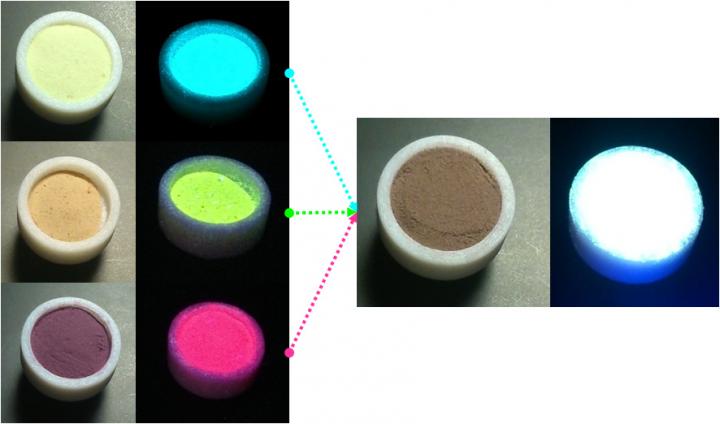

Channelled aluminophosphate with various encapsulated dyes emitting in the blue (acridine), green (pyronin Y) and red (LDS 722) regions of the spectrum, occluded separately (left) or simultaneously in the correct proportions to produce white light (right), under ultraviolet excitation light.
Credit: Rebeca Sola. UPV/EHU
Hybrid materials are those that combine components of differing origins (organic and inorganic) in order to obtain materials different from conventional ones and which display new or improved properties owing to the synergistic effect between their components.
Rebeca Sola, a researcher in the Department of Physical Chemistry in the UPV/EHU's Faculty of Science and Technology, has developed and exhaustively characterised hybrid, photoactive materials –which respond differently when exposed to excitation light– which could have applications in highly different fields, such as optics and biomedicine.
In the research conducted in this department, hybrid materials were obtained, among other things, by incorporating fluorescent dyes, which are routinely used in solution, into channelled inorganic structures. These materials firstly give the dye protection, thus rendering it more stable against degradation and increasing the useful service life of the devices that incorporate them, and secondly, they provide the system with rigidity, which is interesting as this has the potential to increase the photophysical properties of the organic hosts (the dyes).
As the researcher explained, “highly fluorescent materials in which the dyes are found to be ordered were obtained, thus providing a highly anisotropic response to the linearly polarized light”. In other words, materials that respond differently depending on the direction of the polarization of the incident light. Furthermore, it “is fairly straightforward,” to synthesise these materials said Sola. “Crystalline structures in which the dye has already been occluded inside are obtained without any need to apply a diffusion process to insert the dye into the crystal.”
Various optical applications
The researcher has thus obtained materials with a very wide range of optical properties. “Of great interest are those in which there is an artificial antenna effect with the ordering of the different kinds of dye and a unidirectional energy transfer,” she said. This is translated into particles with multi-coloured fluorescence, which are capable of picking up the energy from light at one end and transferring it to the opposite end, which could be of interest with respect to integrating them into solar cells.
Another of the materials obtained is a solid material that emits delayed fluorescence: instead of the fluorescence of the system turning off as soon as the excitation source is removed, as is usually the case, it persists for tenths of a second and is perfectly visible to the naked eye. “This kind of technology could be of interest in LED technologies,” she explained. And materials capable of transforming incident laser light into light with double the amount of energy were also obtained.
These materials not only allow the incorporation of a single dye into the inorganic structure, various dyes can also be simultaneously encapsulated. “With two dyes whose response is complementary, we have obtained fluorescent particles that change colour depending on the light polarization, and change from a blue fluorescent emission to a green one,” added Sola. What is more, it is a reversible, reproducible process”. By incorporating a third, red-emission dye in the correct proportion, a white-light emitting system was also obtained, “once again of interest for illumination systems,” she concluded.
White-light emitters were also obtained by adding small organic molecules to certain frameworks of metal ions and organic compounds known as MOFs (Metal Organic Frameworks); ambient-temperature phosphorescence was also obtained with them. “Phosphorescence is an emission process that routinely calls for very low temperatures to prevent the phosphorescent light from deactivating,” explained Sola.
Leap to biomedicine
The researchers have shown that hybrid materials may have applications in other fields, such as biomedicine. To do this, they used photosensitising substances suitable for photodynamic therapy. These are materials that combine organic and inorganic fragments to produce a kind of oxygen capable of causing the death of certain cells following excitation by light. Photodynamic therapy is a procedure used in dermatology, for example, to treat a range of skin diseases and even for different types of cancer. Materials that not only generate this type of cytotoxic oxygen but which are also fluorescent have been obtained. And “that makes them very useful for bioimaging as well,” added the researcher. “The phototoxic action of these compounds is being explored by means of experiments in in-vitro cell cultures, and although the results are promising, we are still in the early phases of the study,” she concluded.
###
Additional information
This study is part of the PhD thesis by Rebeca Sola-Llano (Barakaldo, 1989), entitled 'Synergism between organic and inorganic moieties: in the search of new hybrid materials for optics and biomedicine'. Her supervisors were the Ramón y Cajal researcher Virginia Martínez-Martínez and the UPV/EHU professor Iñigo López-Arbeloa. Research groups at the Institute of Catalysis and Petrochemistry in Madrid, the Complutense University of Madrid, the University of Kyoto, the Katholieke Universiteit of Leuven and the Autonomous University of Madrid collaborated in this thesis.
Bibliographical reference
M. J. Ortiz, E. Palao, R. Sola-Llano, A. Tabero, H. Manzano, A. R Agarrabeitia, A. Villanueva, I. López-Arbeloa, V. Martinez-Martinez. 'AcetylacetonateBODIPY?biscyclometalated Iridium(III) complexes: Effective strategy towards smarter fluorescent-photosensitizer agents' (2017). Chem. Eur. J. 10.1002/chem.201701347















